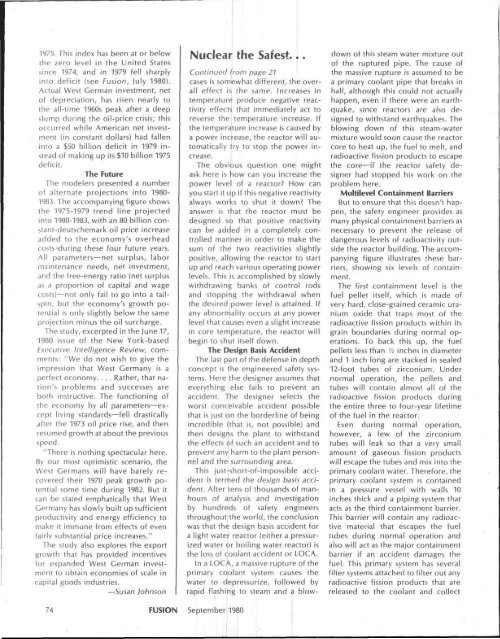fusion energy foundation
fusion energy foundation
fusion energy foundation
- No tags were found...
You also want an ePaper? Increase the reach of your titles
YUMPU automatically turns print PDFs into web optimized ePapers that Google loves.
1975. This index has been at or belowthe zero level in the United Statessince 1974, and in 1979 fell sharplyinto deficit (see Fusion, July 1980).Actual West German investment, netof depreciation, has risen nearly tothe all-time 1960s peak after a deepslump during the oil-price crisis; thisoccurred while American net investment(in constant dollars) had falleninto a $50 billion deficit in 1979 insteadof making up its $10 billion 1975deficit.The FutureThe modelers presented a numberof alternate projections into 1980-1983. The accompanying figure showsthe 1975-1979 trend line projectedinto 1980-1983, with an 80 billion constant-deutschemarkoil price increaseadded to the economy's overheadcosts-during these four future years.All parameters—net surplus, labormaintenance needs, net investment,and the free-<strong>energy</strong> ratio (net surplusas a proportion of capital and wagecosts)—not only fail to go into a tailspin,but the economy's growth potentialis only slightly below the sameprojection minus the oil surcharge.The study, excerpted in the June 17,1980 issue of the New York-basedExecutive Intelligence Review, comments:"We do not wish to give theimpression that West Germany is aperfect economy. . . . Rather, that nation'sproblems and successes areboth instructive. The functioning ofthe economy by all parameters—exceptliving standards—fell drasticallyafter the 1973 oil price rise, and thenresumed growth at about the previousspeed."There is nothing spectacular here.By our most optimistic scenario, theWest Germans will have barely recoveredtheir 1970 peak growth potentialsome time during 1982. But itcan be stated emphatically that WestGermany has slowly built up sufficientproductivity and <strong>energy</strong> efficiency tomake it immune from effects of evenfairly substantial price increases."The study also explores the exportgrowth that has provided incentivesfor expanded West German investmentto obtain economies of scale incapital goods industries.—Susan JohnsonNuclear the Safest...Continued Horn page 21cases is somewhat different, the overalleffect is the same. Increases intemperature produce negative reactivityeffects that immediately act toreverse the temperature increase. Ifthe temperature increase is caused bya power increase, the reactor will automaticallyfry to stop the power increase.The obvious question one mightask here is how can you increase thepower leve of a reactor? How canyou start it Up if this negative reactivityalways works to shut it down? Theanswer is that the reactor must bedesigned so that positive reactivitycan be added in a completely controlledmanner in order to make thesum of the two reactivities slightlypositive, allowing the reactor to startup and reach various operating powerlevels. This is accomplished by slowlywithdrawing banks of control rodsand stopping the withdrawal whenthe desired power level is attained. Ifany abnormality occurs at any powerlevel that causes even a slight increasein core terrjperature, the reactor willbegin to shut itself down.The Design Basis AccidentThe last part of the defense in depthconcept is the engineered safety systems.Here the designer assumes thateverything else fails to prevent anaccident. The designer selects theworst conceivable accident possiblethat is just on the borderline of beingincredible (that is, not possible) andthen designs the plant to withstandthe effects of such an accident and toprevent any harm to the plant personneland the surrounding area.This just-short-of-impossible accidentis termed the design basis accident.After tens of thousands of manhoursof analysis and investigationby hundreds of safety engineersthroughout the world, the conclusionwas that the design basis accident fora light water reactor (either a pressurizedwater or boiling water reactor) isthe loss of coolant accident or LOCA.In a LOCA, a massive rupture of theprimary coolant system causes thewater to depressurize, followed byrapid flashing to steam and a blowdownof this steam water mixture outof the ruptured pipe. The cause ofthe massive rupture is assumed to bea primary coolant pipe that breaks inhalf, although this could not actuallyhappen, even if there were an earthquake,since reactors are also designedto withstand earthquakes. Theblowing down of this steam-watermixture would soon cause the reactorcore to heat up, the fuel to melt, andradioactive fission products to escapethe core—if the reactor safety designerhad stopped his work on theproblem here.Multilevel Containment BarriersBut to ensure that this doesn't happen,the safety engineer provides asmany physical containment barriers asnecessary to prevent the release ofdangerous levels of radioactivity outsidethe reactor building. The accompanyingfigure illustrates these barriers,showing six levels of containment.The first containment level is thefuel pellet itself, which is made ofvery hard, close-grained ceramic uraniumoxide that traps most of theradioactive fission products within itsgrain boundaries during normal operations.To back this up, the fuelpellets less than Vi inches in diameterand 1 inch long are stacked in sealed12-foot tubes of zirconium. Undernormal operation, the pellets andtubes will contain almost all of theradioactive fission products duringthe entire three to four-year lifetimeof the fuel in the reactor.Even during normal operation,however, a few of the zirconiumtubes will leak so that a very smallamount of gaseous fission productswill escape the tubes and mix into theprimary coolant water. Therefore, theprimary coolant system is containedin a pressure vessel with walls 10inches thick and a piping system thatacts as the third containment barrier.This barrier will contain any radioactivematerial that escapes the fueltubes during normal operation andalso will act as the major containmentbarrier if an accident damages thefuel. This primary system has severalfilter systems attached to filter out anyradioactive fission products that arereleased to the coolant and collect74 FUSION September;1980
















